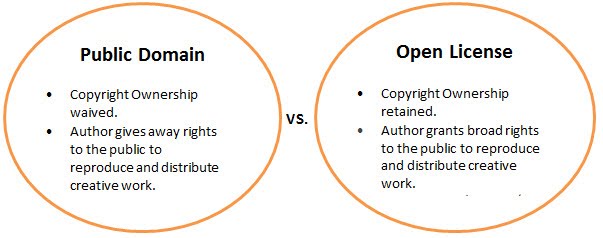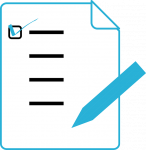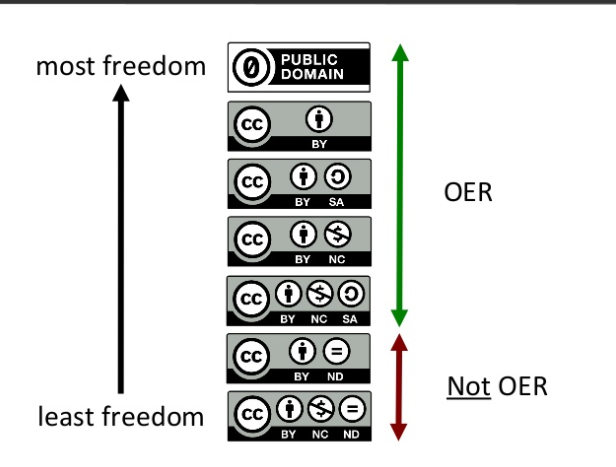OER Toolkit – About OER

About Open Educational Resources
Do you want to know about Open Educational Resources? This module presents an overview of what they are, why they matter to education and how to get started on your OER journey.
Open Educational Resources (OER) are freely accessible, openly licensed text, media, and other digital assets that are useful for teaching, learning, and assessing as well as for research purposes.
The development and promotion of open educational resources is often motivated by a desire to provide an alternate or enhanced educational paradigm.
Most OER materials are released under an open license or reside in the public domain. The difference between the public domain items and the open license items is shown below.

Public Domain versus Open License Diagram
What are Open Educational Resources (OER)?
Open Educational Resources, or OER, refer to any teaching and learning materials that reside in the public domain or have been released under an open license, such as a Creative Commons License. This allows for no cost access, use, adaptation and redistribution (See “The 5Rs of OER” tab) with limited or no restrictions.






Attribution: OER Can Be and the associated images are a derivative of BCOER Poster by BCCampus licensed under CC by 4.0
Definition of OER is from UNESCO and The William and Flora Hewlett Foundation.
The Five Permissions of OER
The “5Rs” is a framework that encourages educators to capitalize on the unique rights associated with open content. These rights include the ability to:
- Retain: Make and own copies of the work (e.g., download, duplicate, store, and manage)
- Reuse: Use the work in a wide range of ways (e.g., in a class, in a study group, on a website, in a video)
- Revise: Adapt, modify and translate the work (e.g., translate the content into another language)
- Remix: Combine it with another resource to make a new work (e.g., incorporate the content into a mashup)
- Redistribute: Share the work with others (e.g., give a copy of the content to a friend)
These rights, or permissions, are made possible through open licensing. For example, Creative Commons open licenses help creators of OER retain copyright while allowing others to reproduce, distribute, and legally use their work.
Attribution: The 5 Rs of OER is a derivative of the 5 R Permissions of OER by Lumen Learning licensed under CC BY 4.0
What’s Not OER
Below are five key categories of resources that are often considered to fall outside the definition of what is truly OER and should not be included in Nebraska’s OER Commons Hub. Of course, the best mix of materials to meet any given set of learning outcomes will vary, and may include a combination of OER and the materials listed below. The key is knowing which resources will best meet the objectives for instruction, and for learners.
1. Resources that Cannot be Adapted
Through open licensing, the mission of the OER movement is to encourage the full range of “The 5Rs of OER” permissions of use (see prior tab). Some argue that unless an open license allows for adaptations, then the resource is not truly OER.
The image below illustrates Creative Commons Licenses on a spectrum from more to less open. As depicted, resources that are licensed ND (No Derivatives), are in some cases considered not to be OER.
Attribution: The Six Creative Commons Licenses image is a derivative of an image by Cable Green, licensed under CC BY 4.0.
2. Online Resources that are Fully Copyrighted
Online resources that are accessible without an open license are not OER. Open License includes Creative Commons licensing and public domain. Not all copyrighted resources include a copyright logo. If the copyright indication is not present, contact the author of the resource and ask for permission.
3. Subscription-Based Resources
All subscription-based resources (journals, videos, and other materials), while accessible to students and teachers, are also not OER. This is because their use in education may be limited by license agreements.
4. Purchased Textbook & Supplemental Materials
Copyright restricted textbooks consist of materials that may have been purchased through a publisher are not OER. Many of these textbooks also come with copyrighted supplemental teaching items that are also not OER. This may include:
~ Instructor Guides and Keys
~ Student Workbooks
~ Test and Quiz Materials
~ Videos and Articles
~ Lesson Plans
5. Open Access Resources
Open access is an important concept, which is related to – but distinct from – that of OER. Open access typically refers to research publications released under an open license that allows for their free access and use (definition from Basic Guide to Open Educational Resources, 2015.
Open access publications do not usually allow for adaptation and remixing. While open access articles are freely accessible, authors may retain their copyright and/or assign rights to publishers or users, so permission may be needed for copying and adaptation.
More information about Open Access:
- Introduction to Open Access (a flyer), from CARL
There are many benefits to using OER for educators and students:
- Lower Educational Resource Costs
- Allows for Sharing
- Allows for Collaboration
- Content can be Adapted for All Students
- Provides Equitable Access
- Easily Aligned to Content Standards
- Greater Accessibility
- Easily Updated
CCSSO Report/Article – State of the States: Open Educational Resources in K-12 Education
Office Education Technology – Why Use Open Educational Resources?





